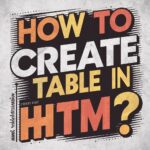Introduction:
In HTML, lists are used to group related items together. They help organize content in a structured and readable way. There are three types of lists in HTML: Ordered Lists (<ol>), Unordered Lists (<ul>), and Definition Lists (<dl>). Each serves a different purpose and has specific characteristics.

1. Ordered Lists (<ol>):
An ordered list is used when the order of items matters. Each item in the list is numbered.
Syntax:
<ol>
<li>First item</li>
<li>Second item</li>
<li>Third item</li>
</ol>
Explanation:
<ol>stands for “ordered list”.<li>stands for “list item”. Each item in the list is wrapped in an<li>tag.- The list items are automatically numbered by the browser.
Attributes:
type: Specifies the type of numbering (e.g.,1,A,a,I,i).start: Specifies the starting number for the list.reversed: Reverses the order of the list.
Example:
<ol type="A" start="3">
<li>Item A</li>
<li>Item B</li>
<li>Item C</li>
</ol>
2. Unordered Lists (<ul>):
An unordered list is used when the order of items does not matter. Each item is marked with a bullet point.
Syntax:
<ul>
<li>First item</li>
<li>Second item</li>
<li>Third item</li>
</ul>
Explanation:
<ul>stands for “unordered list”.<li>stands for “list item”. Each item in the list is wrapped in an<li>tag.- The list items are marked with bullet points by default.
Attributes:
type: Specifies the type of bullet (e.g.,disc,circle,square).
Example:
<ul type="square">
<li>Item 1</li>
<li>Item 2</li>
<li>Item 3</li>
</ul>3. Definition Lists (<dl>):
A definition list is used to create a list of terms and their definitions.
Syntax:
<dl>
<dt>Term 1</dt>
<dd>Definition of Term 1</dd>
<dt>Term 2</dt>
<dd>Definition of Term 2</dd>
</dl>
Explanation:
<dl>stands for “definition list”.<dt>stands for “definition term”. Each term is wrapped in a<dt>tag.<dd>stands for “definition description”. Each definition is wrapped in a<dd>tag.
Example:
<dl>
<dt>HTML</dt>
<dd>HyperText Markup Language</dd>
<dt>CSS</dt>
<dd>Cascading Style Sheets</dd>
</dl>

Nested Lists:
Lists can be nested inside other lists, allowing for complex structures.
Example:
<ul>
<li>Item 1
<ul>
<li>Subitem 1.1</li>
<li>Subitem 1.2</li>
</ul>
</li>
<li>Item 2</li>
</ul>
Explanation:
- An unordered list is nested inside another unordered list.
- This creates a hierarchical structure.
Exam Note:
- Definition: Lists in HTML are used to group related items together in a structured way. The three types of lists are Ordered Lists (
<ol>), Unordered Lists (<ul>), and Definition Lists (<dl>). - Ordered List (
<ol>): Displays items in a numbered format. Use<ol>for the list and<li>for each item. Attributes:type,start,reversed. - Unordered List (
<ul>): Displays items with bullet points. Use<ul>for the list and<li>for each item. Attribute:type. - Definition List (
<dl>): Displays terms and their definitions. Use<dl>for the list,<dt>for each term, and<dd>for each definition. - Nested Lists: Lists can be nested to create complex structures.
By understanding these concepts, students can effectively use lists to organize content in HTML, enhancing readability and structure.
Example of List (ordered , unordered , definition list)
<!DOCTYPE html>
<html lang="en">
<head>
<meta charset="UTF-8">
<meta name="viewport" content="width=device-width, initial-scale=1.0">
<title>HTML Lists Example</title>
</head>
<body>
<h1>HTML Lists Example</h1>
<!-- Ordered List -->
<h2>Ordered List</h2>
<ol type="A" start="3">
<li>Third item</li>
<li>Fourth item</li>
<li>Fifth item</li>
</ol>
<!-- Unordered List -->
<h2>Unordered List</h2>
<ul type="square">
<li>First item</li>
<li>Second item</li>
<li>Third item</li>
</ul>
<!-- Definition List -->
<h2>Definition List</h2>
<dl>
<dt>HTML</dt>
<dd>HyperText Markup Language</dd>
<dt>CSS</dt>
<dd>Cascading Style Sheets</dd>
<dt>JavaScript</dt>
<dd>A programming language commonly used in web development</dd>
</dl>
<!-- Nested List -->
<h2>Nested List</h2>
<ul>
<li>Item 1
<ul>
<li>Subitem 1.1</li>
<li>Subitem 1.2</li>
</ul>
</li>
<li>Item 2
<ol>
<li>Subitem 2.1</li>
<li>Subitem 2.2</li>
</ol>
</li>
</ul>
</body>
</html>
here is how the output would look for the given HTML code:
HTML Lists Example
Ordered List
C. Third item
D. Fourth item
E. Fifth item
Unordered List
- First item
- Second item
- Third item
Definition List
HTML
- HyperText Markup Language
CSS
- Cascading Style Sheets
JavaScript
- A programming language commonly used in web development
Nested List
- Item 1
- Subitem 1.1
- Subitem 1.2
- Item 2
- Subitem 2.1
- Subitem 2.2
This will be the visual representation of the lists when the HTML code is rendered in a browser.


